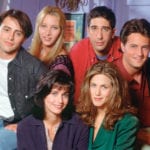 History
History  History
History  Creepy
Creepy 10 More Representations of Death from Myth, Legend, and Folktale
 Technology
Technology 10 Scientific Breakthroughs of 2025 That’ll Change Everything
 Our World
Our World 10 Ways Icelandic Culture Makes Other Countries Look Boring
 Misconceptions
Misconceptions 10 Common Misconceptions About the Victorian Era
 Mysteries
Mysteries 10 Strange Unexplained Mysteries of 2025
 Miscellaneous
Miscellaneous 10 of History’s Most Bell-Ringing Finishing Moves
 History
History 10 Great Escapes That Ended Right Back in Captivity
 Weird Stuff
Weird Stuff 10 Fascinating Things You Might Not Know About Spiders
 Food
Food 10 Everyday Foods You Didn’t Know Were Invented by the U.S. Military
 History
History 10 Most Influential Protests in Modern History
 Creepy
Creepy 10 More Representations of Death from Myth, Legend, and Folktale
 Technology
Technology 10 Scientific Breakthroughs of 2025 That’ll Change Everything
Who's Behind Listverse?

Jamie Frater
Head Editor
Jamie founded Listverse due to an insatiable desire to share fascinating, obscure, and bizarre facts. He has been a guest speaker on numerous national radio and television stations and is a five time published author.
More About Us Our World
Our World 10 Ways Icelandic Culture Makes Other Countries Look Boring
 Misconceptions
Misconceptions 10 Common Misconceptions About the Victorian Era
 Mysteries
Mysteries 10 Strange Unexplained Mysteries of 2025
 Miscellaneous
Miscellaneous 10 of History’s Most Bell-Ringing Finishing Moves
 History
History 10 Great Escapes That Ended Right Back in Captivity
 Weird Stuff
Weird Stuff 10 Fascinating Things You Might Not Know About Spiders
 Food
Food 10 Everyday Foods You Didn’t Know Were Invented by the U.S. Military
Top Ten Times TV Shows Got Experimental
Given the sheer volume of material that television so often demands, it can be very easy for a show to get stale before its time. That’s why, aside from just keeping the quality of the material up to a high standard, writers will often try to keep things interesting by experimenting with the form, creating special episodes that are immediately able to stand out from the pack. And as we’ll see in this list, this can be achieved in a variety of ways—be it structure, form, subject material, or filming techniques, just to name a few.
So with that in mind, here are ten of what I feel are the best times your favorite TV shows got experimental. Oh, be warned, there are spoilers ahead!
Related: 10 Episodes That Were Banned From Television [Videos—Seizure Warning]
10 Buffy the Vampire Slayer – “The Body”
Joss Whedon’s magnus opus could almost fill up this entire list itself, what with him dipping into silent horror in the critically acclaimed “Hush” or the musical genre in the equally as beloved “Once More With Feeling.” That said, there’s perhaps no better example of the show experimenting with the form than how it explored the grief that comes with the death of a loved one in season five’s “The Body.”
During this spectacular hour of television, we would get to see each character deal with Joyce Summer’s passing, with reactions ranging from Willow’s deflection of the issue in favor of her choice of clothing to Anya’s inability to understand the full extent of human mortality. And when Buffy’s calls her mother the body for the first time, and it all finally hits home for her, it’s hard not to feel the heartbreak she’s going through at that moment, especially as the starkness of the entire episode is highlighted by the distinct lack of music or any real antagonist other than death itself.[1]
9 Seinfeld – “The Betrayal”
Seinfeld really was a game-changer for sitcoms in the ‘90s. By this point, the genre had been very much rooted in maintaining the same status quo of middle-of-the-road comedy for decades. However, Larry David and Jerry Seinfeld seemed intent on forging new paths, creating groundbreaking episodes of TV, like season two’s “The Chinese Restaurant” or season four’s “The Contest.” But it wouldn’t be until season nine’s “The Betrayal” that they dared to try something as bold as to do an episode in reverse.
Yes, here we would get to see things begin with the final scene of Jerry setting up George with an old flame named Nina, then watch things fall apart from there as we travel back in time toward the beginning. And despite the whole thing, which was inspired by a Harold Pinter play of the same name, ending up working out great, it was actually considered a little too out there by some fans at the time. Many of them even complained about its unconventional structure and went as far as creating forward version edits that would later be posted online.[2]
8 BoJack Horseman – “Fish Out of Water”
BoJack Horseman started out as a relatively standard adult animated comedy show reminiscent of others of the era like Bobs Burgers or Archer. Toward the end of season one, though, it began to undergo a change that would see it become more of a mediation on depression, with each character going through their own struggles with this as the show progressed.
And of course, as the lead character, BoJack would be no stranger to this. It was something that came to the forefront during the excellent season three episode “Fish Out of Water,” where, as a result of him spending the proceedings attending an underwater movie festival to promote his Secretariat biopic, things would play out like a silent movie. He tries and fails to apologize to the former director of the movie who he had gotten fired, with the whole thing from there carrying on like a Chaplin movie and ending in a truly classic gag.[3]
7 The Sopranos – “The Test Dream”
You could argue that David Chase’s The Sopranos is the most game-changing show in TV history, given that it’s largely been responsible for the birth of modern prestige television. And during its six-season run, it would be no stranger to pushing the boat out further than anyone else with its often shocking storylines and incredibly well-drawn characters.
In terms of experimenting with the form, though, nothing comes close to the season five episode “The Test Dream,” during which a full half of the episode plays out as an extended dream sequence. And while the show had done dream sequences before, it was never on this large of a scale. Over the course of twenty minutes, we got to take a Freudian deep dive into the psyche of the show’s flawed protagonist. This not only allowed a whole host of dead characters to briefly return but also let Tony come to terms with the fact that he was going to have to kill his own blood in the near future.[4]
6 The Simpsons – “Behind the Laughter”
While generally regarded as one of the greatest TV shows of all time, The Simpsons has often played out like a mostly traditional sitcom in terms of its structure, usually functioning with an A and B plot working alongside each other to bring the laughs. That said, they haven’t been afraid to break out of this mold from time to time. Perhaps no example of this was more noticeable than season twenty-two’s “Behind the Laughter.”
Here the whole thing would serve as an extended parody of the VH1 Behind the Music series as we got to see the cast of characters talk about the difficulties of working on the show and how it affected their relationships with each other. And so good did the whole thing end up being that when asked in a later interview about what he thought could serve as a fitting finale for the series, showrunner Al Jean singled out this episode specifically as one of the best candidates.[5]
5 Community – “Remedial Chaos Theory”
Community is another show that played around with the form so much that it could almost fill up this list itself. And while there are many examples of this we could have chosen here, such as season one’s “Modern Warfare” or season two’s “Abed’s Uncontrollable Christmas,” we think season three’s “Remedial Chaos Theory” marks the best time that the Community gang got experimental.
Here, over a game of Yahtzee with the six friends, we would get to see each new dice roll cause a timeline of possibilities to branch off from it. The darkest among them would see Annie accidentally shoot Piece in the leg, causing Britta to drop her joint and set fire to the apartment. And so popular did this episode and this particular timeline end up being, in fact, it would return to invade the main one in the season four finale, “Advanced Introduction to Finality.”[6]
4 The Haunting of Hill House – “Two Storms”
Netflix’s history of original shows has been a spotty one. Sure, they’ve had some major hits, but for every Stranger Things or Daredevil, there have been less successful shows such as Space Force or the Cowboy Bebop remake. Still, whenever they hit it out of the park, they do so fully. And few new entries to their canon in recent years have done this more successfully than their 2018 reimagining of the Shirley Jackson classic The Haunting of Hill House.
But while this mini-series made use of a more single extended story format than the episodic structure of many other entries on this list, there was one episode in particular that stood out for its use of single takes. Yes, in the sixth episode entitled “Two Storms,” we would get to see the show drift back and forth between its two timelines, maintaining one mostly long unbroken take as it did. And this decision, with its echoes towards Alfred Hitchcock’s Rope, ending up not only highlighting the strength of the storytelling on display but also the acting and production in a way it wouldn’t have been able to do otherwise.[7]
3 Breaking Bad – “Fly”
Vince Gilligan’s masterpiece Breaking Bad has by this point developed a reputation for being arguably the greatest TV show of its era. Its story of the fall of a once-good man and the destruction he reaped on everyone around him grabbed the audience’s attention completely from the very first second. And while almost every episode of the show has been universally praised, there’s one which fans remain divided on to this day: the season three episode “Fly.”
And part of the reason for that is that it feels so different from the rest of the series. Instead of featuring the high octane moral dilemmas that most episodes are filled with, this one slows things down, focusing entirely on Walt and Jesse’s attempts to kill a pesky fly that’s been roaming around their underground meth lab. But while some felt this story was jarring at the time, others were able to appreciate it for what it was. It played out like a two-man play, where we would get to really dive into the depths of Walt’s internal struggles as he tries his best to atone for his part in the death of his partner’s girlfriend Jane, all while wanting to continue to keep the whole incident a dirty little secret.[8]
2 ER – Ambush
There’s a lot of room for error during the filming of a TV episode. Takes can easily get messed up, and reshoots are often required. So it’s a risky move then to decide to film an episode live. And while ER certainly wasn’t the first show to attempt this, they were maybe the one who pulled it off best during their season four episode “Ambush.”
Yes, it was here that we would see a documentary crew follow the staff of the fictional Chicago hospital around. This served as an excuse for the whole thing to be filmed in a different style. But more important than this, the episode was actually aired live, making the whole thing come off more like a stage show as audiences watched and waited to see if they could successfully pull the whole thing off. Which, in the end, they did.[9]
1 Twin Peaks: The Return – “Part Eight”
And finally, we reach the granddaddy of experimental television, something which, fittingly, was created by one of the greatest avant-garde filmmakers of all time, David Lynch.
Of course, Twin Peaks had always been known as a TV show willing to push the boundaries throughout its original run in the early ‘90s, with locations such as the Red Room and characters like Killer Bob wowing audiences at the time. That said, it would be the 2017 revival of the show Twin Peaks: The Return that would allow its creator to go full Lynch. During “Part Eight,” he gave audiences one of the most challenging and beautiful hours of television ever seen on a small screen.
There’s less of a narrative here and more of an extended dream logic. Through often abstract imagery and unclear temporal placement, we get to dive into the rich mythology of the show, possibly getting the origins of the main villain Judy and maybe even seeing the fabled White Lodge for the first time. As with all of Lynch’s more abstract work, however, this all remains open to interpretation. So, if for any reason you haven’t seen this one yet, go back and check it out now. I promise you won’t be disappointed.[10]








